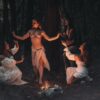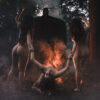The Importance of In-Person Instruction for Rope
I want to start by saying, if you have only learned rope through books, videos, online sessions and the like, you should definitely GET SOME IN-PERSON INSTRUCTION, particularly if you’re hoping to work towards higher-risk rope (predicament, partial suspension, full suspension, etc.).
That DOES NOT HAVE TO BE FROM ME!
But if you’re going to do rope that can put the safety of others at risk, you should seek out skilled and experienced in-person instruction from someone or from some group. There are many social / skill-share groups that can help as well as education-focused groups and classes (like Rope Study for instance).
- It’s impossible to learn proper tension–what it is, how to create it, and how it feels or should feel on the body–without in-person feedback.
- It’s very difficult to learn how to adapt a tie to a specific body (vs. trying to adapt a body to a tie) without in-person feedback.
- There are things you don’t know you need to know that you won’t learn you need to know without someone with experience working with you in real-time, and some of those things are difficult or impossible to recognize without in-person feedback.
- There are a myriad of misunderstandings–small and inconsequential to significant and risk-inducing–that are difficult to catch without in-person feedback. And when you’re first learning how to tie/be tied, it’s nearly impossible to tell the difference between inconsequential and significant misunderstandings without … well, you know.
So yeah, in my opinion and based on my experience in the rope world for 10+ years, I really think anyone aspiring to do rope beyond decorative, bedroom, or simple floor work should most definitely get in-person instruction from an experienced and vetted someone.
Rope Instruction
I have been practicing rope bondage art since early 2012 and primarily tie in the style inspired by Japanese rope bondage (shibari / kinbaku). During that time, I learned from a wide range of both local and international rope tops and bottoms. I also founded and ran RVA Rope from 2012 through 2018 and founded Rope Study in 2016.
While I am happy to work with those brand-new to rope, I will probably be more helpful to those who have been practicing rope for a while and are looking to refine their technique, solve a persistent issue, take the next step in their rope journey, or receive feedback and suggestions for improvement on their current rope work.
Areas of rope instruction that I feel are my strongest include:
- Understanding and mitigating risk
- Understanding forms (not just memorizing patterns)
- Rope control skills for creating solid structures through effective placement and tension
- Understanding and mitigating the increased risks in suspension
- Creating effective suspension points
- Creating and managing up-lines, including considerations for attaching to ties
- The importance of order, levels, and timing in suspension (partial or full)
- Working in partial suspension and all the benefits it brings
- Working in full suspension and developing the necessary awareness and efficiency
- Transitions in partial or full suspension
Photography Instruction
I have been practicing photography in one form or another since the 1990s. I’m happy to help people get started in photography or to work on more specific or advanced techniques.
Areas of photography instruction that I feel are my strongest include:
- Learning to fully control your camera
- Techniques for capturing images with broader artistic appeal (experimenting with composition, considering the light, capturing emotion, telling a story, focusing on details, etc.)
- Working with natural light
- Working with off-camera flash
- Shooting rope photography
- Editing workflows with Lightroom and Photoshop
Location and Time
Rope instruction will be held at my private rope studio located just north of Richmond. I typically have availability on weekday evenings between 7 and 10 pm. I may have some weekend days available with advanced notice.
There is a 1 hour minimum for instruction, though I recommend 2 hours per session in most cases.








